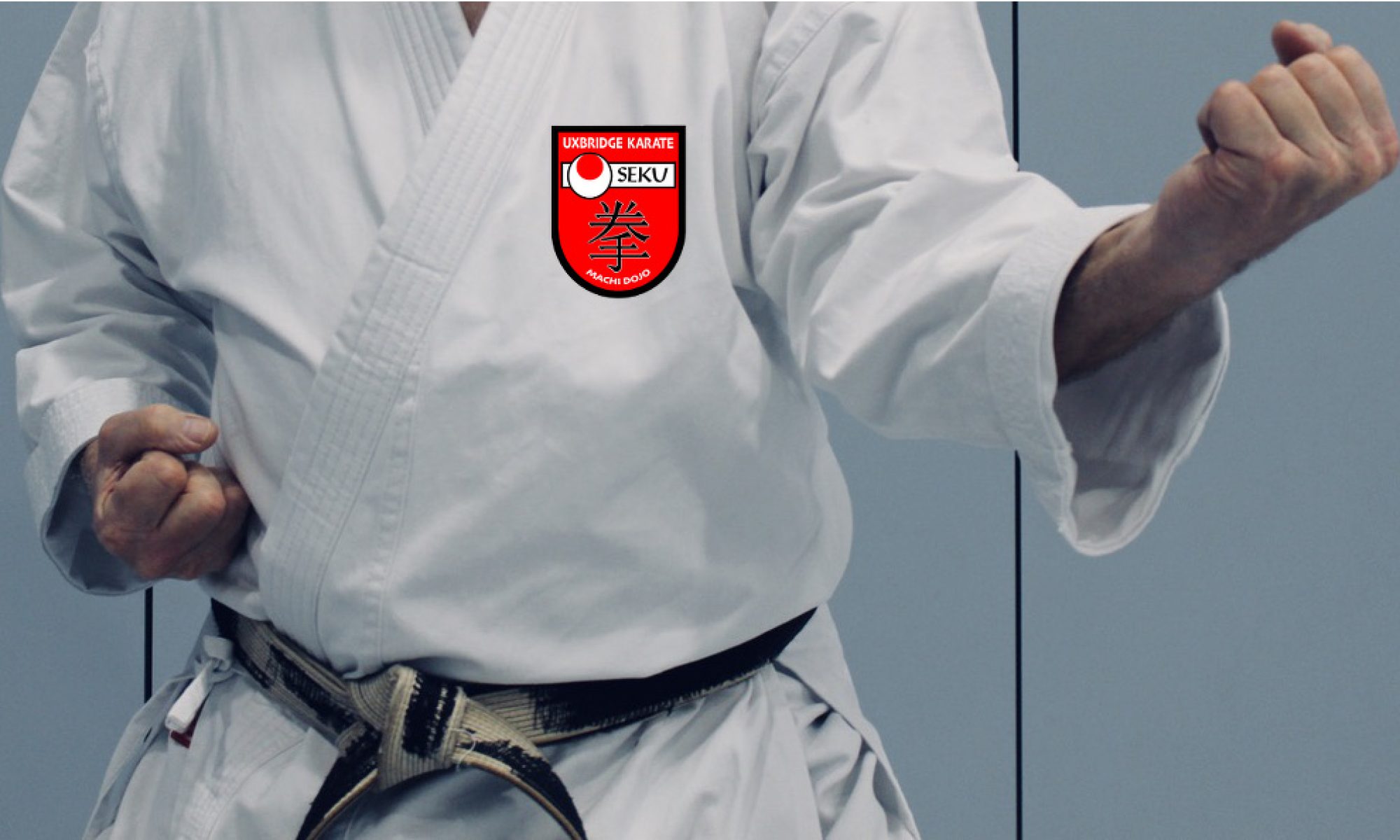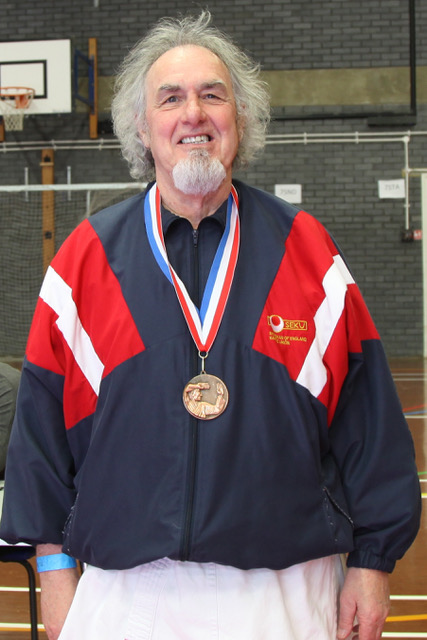At Machi Dojo we provide regular Shotokan Karate training in Uxbridge Middlesex. We endeavour to maintain the high standards that are set by the Shotokan of England Karate Union.
We typically work in mixed groups with students of varying levels of experience and fitness who only require a keenness to train and learn. In fact, no experience is necessary to start the Karate journey. Students can range from children of 6 and above through to juniors and adults with no upper age limit.
The Dojo is open to anyone who wishes to take advantage of our Free First Lesson, or just come along and watch to see if karate is for you before taking the first step onto the dojo floor.
As parents are you looking for your children to put down social media and electronic-games for a short time to progress the development of life skills and also gain self-defence skills, which are so important in todays society. Why not bring them along and if it works for you participate in the lesson yourself whilst you are at the dojo and make it shared fun family time. Discounts available for families.
The Dojo is also open to adults who wish to train intermittently on a casual basis through to dedicated Karateka and those returning to the karate journey. Discounts available on a pay monthly basis.
No matter if you are child, junior or adult the benefits of Karate include:
- Fitness and endurance;
- Mental focus and concentration;
- Respect and discipline;
- Flexibility;
- Self – defence techniques, protection and practical application;
- Awareness and self control;
- Self development, self confidence and self esteem;
- Teamwork, supporting others and cooperation;
- Part of a club and making new friends.
It’s all in the title “Martial Art” which is a journey of learning, dedication and hard work for all members, not just serious Karateka. No matter what level you are in the journey, being a child, junior or adult starting out or experienced Black Belt, we always remind our members of the absolute requirement for respect and control of the karate skills being develop, whether in or outside the dojo.
If you are interested in having a go, give us a call or email us here.




 lookout for interesting stories, the latest news about SEKU members and Martial Arts in general. Ken also compiled the Shotokan Pocket Book available from all good book stores (e.g. Amazon.com).
The book contains Japanese phrases, terms and names of the techniques used in Shotokan Dojos and in competitions. This is an ideal Christmas or Birthday present for your favourite Kohai or Sempai and I expect Sensei has already got a copy tucked inside his Gi and that’s why he knows so much. The book was designed to be a comprehensive companion to Karateka of all levels.
lookout for interesting stories, the latest news about SEKU members and Martial Arts in general. Ken also compiled the Shotokan Pocket Book available from all good book stores (e.g. Amazon.com).
The book contains Japanese phrases, terms and names of the techniques used in Shotokan Dojos and in competitions. This is an ideal Christmas or Birthday present for your favourite Kohai or Sempai and I expect Sensei has already got a copy tucked inside his Gi and that’s why he knows so much. The book was designed to be a comprehensive companion to Karateka of all levels.
 of 2001 Ken was bitten on the ankle by a spider and ended up on his back in hospital with an intravenous dip in his arm for some weeks. With his brain fully functional but with a body confined to the hospital bed, the days ticked by as he watched the infection spread up his leg. The team of doctors would gather around each day and mark his leg with felt-tipped pens as they
contemplated amputation of the lower section of his leg in order to save the knee joint. He was desperately missing the training session and spent most of his time reading Karate books that he had accumulated over the years but never had time to read. Eventually, the antibiotics began to work and his leg was saved but during the four weeks in hospital and additional weeks of convalescing at home his brain was a sponge soaking up data on Karate and the history of Japanese martial arts. Ken was hungry for more information and he tried to find a comprehensive book on Shotokan Karate that contained all the data and answers to the most common questions but discovered that there was not one available. This was the seed of the Shotokan Pocket Book.
of 2001 Ken was bitten on the ankle by a spider and ended up on his back in hospital with an intravenous dip in his arm for some weeks. With his brain fully functional but with a body confined to the hospital bed, the days ticked by as he watched the infection spread up his leg. The team of doctors would gather around each day and mark his leg with felt-tipped pens as they
contemplated amputation of the lower section of his leg in order to save the knee joint. He was desperately missing the training session and spent most of his time reading Karate books that he had accumulated over the years but never had time to read. Eventually, the antibiotics began to work and his leg was saved but during the four weeks in hospital and additional weeks of convalescing at home his brain was a sponge soaking up data on Karate and the history of Japanese martial arts. Ken was hungry for more information and he tried to find a comprehensive book on Shotokan Karate that contained all the data and answers to the most common questions but discovered that there was not one available. This was the seed of the Shotokan Pocket Book.
 The Shotokan Pocket Book is a compilation of the translation of Karateka Terminology and other Japanese words and phrases into English. This book has been written to assist students of Karate-Do and to supplement their training and learning processes. Both junior and senior Karateka should find this book useful.
The primary objective of the book has been to provide a comprehensive reference book that lists the various Japanese terms, commands and expressions that are used when training in the dojo and when taking part in competition. Sections 2 to 19 are devoted to this.
Section 1 explains the general rules of pronunciation of Japanese for the English speaking tongue. It is important to spend time understanding the basic principles that should assist students to read and annunciate Japanese words correctly.
Sections 20, 21 and 22 contain the Dojo Kun, the 20 Precepts of Gichin Funakoshi and Japanese numbers from one to one hundred respectively for quick reference.
The Shotokan Pocket Book is a compilation of the translation of Karateka Terminology and other Japanese words and phrases into English. This book has been written to assist students of Karate-Do and to supplement their training and learning processes. Both junior and senior Karateka should find this book useful.
The primary objective of the book has been to provide a comprehensive reference book that lists the various Japanese terms, commands and expressions that are used when training in the dojo and when taking part in competition. Sections 2 to 19 are devoted to this.
Section 1 explains the general rules of pronunciation of Japanese for the English speaking tongue. It is important to spend time understanding the basic principles that should assist students to read and annunciate Japanese words correctly.
Sections 20, 21 and 22 contain the Dojo Kun, the 20 Precepts of Gichin Funakoshi and Japanese numbers from one to one hundred respectively for quick reference.
 Whilst the terms used are primarily the same for all of the popular Japanese Karate styles there are some variations and differences in spelling and pronunciation. This book attempts to take account of this fact and includes the most popular alternatives where applicable. Whilst this book will therefore be useful to Karateka of all styles it focuses on the Shotokan style and therefore Section 14 contains the 26 Shotokan Kata. In addition, this section contains other terms that are used in relation with Kata and one or two Kata performed by other styles that are of particular interest to Shotokan Karateka.
Whilst the terms used are primarily the same for all of the popular Japanese Karate styles there are some variations and differences in spelling and pronunciation. This book attempts to take account of this fact and includes the most popular alternatives where applicable. Whilst this book will therefore be useful to Karateka of all styles it focuses on the Shotokan style and therefore Section 14 contains the 26 Shotokan Kata. In addition, this section contains other terms that are used in relation with Kata and one or two Kata performed by other styles that are of particular interest to Shotokan Karateka.